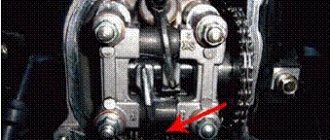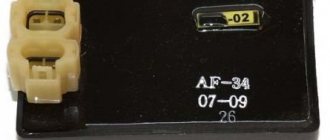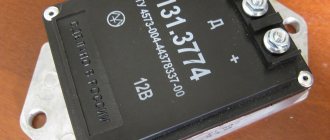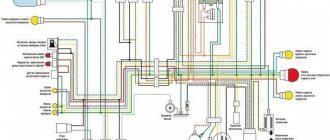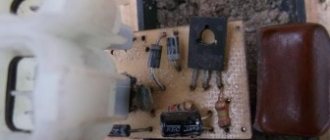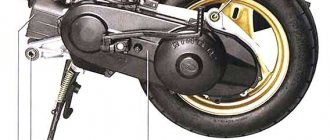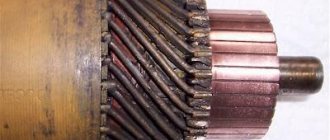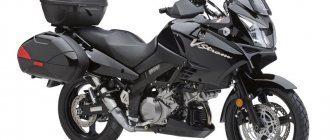Stock switch for scooter
A stock or original switch is the one that is installed on the vehicle from the factory. Its main advantage over others is that it is already designed for the equipment with which it operates; it is often equipped with a limiter so that the engine does not develop speeds that are dangerous to the life and life of the main bearings, the entire crank mechanism, cylinder-piston groups and other structures and assemblies. The stock commutator is the main source of a well thought out engine's longevity, efficiency and durability. Those who take the risk of replacing a factory switch with a sports (tuning) one are risking a lot. Those who do not fully understand what they intend to do risk even more. Inept installation of such parts and their subsequent use with a conventional engine often lead to a decrease in service life and the death of the engine, sometimes on the same day.
Weight check
If there is any suspicion of a malfunction of any scooter ignition module, the ground is first checked. Although, mass in two-wire wiring is a relative concept, but for now let’s call it that.
We take the tester, switch it to the “continuity” mode (diode icon or sound signal icon), look for green wires on the switch - this is something other than ground (in Feng Shui - negative wire), touch the metal part of the engine with any probe of the tester, with another poke the probe into the green wires:
- If there is mass, the tester will beep
- If the mass is bad, numbers will appear on the tester display
- If there is no mass, the tester will be silent, and the screen will show only zeros
Depending on what the tester shows you, fix the problem or continue testing:
- If the ground is bad, look for a break or oxidation in the wiring
- If there is no ground, look for an open circuit or connect it directly from the engine
- If there is mass, but there is no spark, we continue checking
An example of a good mass: the tester beeps in the “dialing” mode, the display shows solid zeros
What is a switch and why is it needed?
To put it simply, a switch is a certain module (according to Feng Shui - a DC CDI or AC CDI module) in which electrical energy is accumulated, which at the right moment is supplied in the form of a pulse to the ignition coil, where it is multiplied many times and jumps out in the form of an electric spark between the spark plug electrodes.
Depending on the type of commutator, the energy necessary for the formation of spawn can be accumulated in the commutator in two ways:
- On switches of the AC CDI type - the energy required to form a spark on the spark plug is first formed in the high-voltage coil of the generator and then, in the form of alternating current, enters the switch, where it accumulates in the capacitor and at the right moment is supplied to the ignition coil in the form of a pulse
- On DC CDI type switches, the energy required to form a spark on the spark plug in the form of direct current comes directly from the battery, where it is converted into alternating current, multiplied by voltage and supplied to the capacitor
The switch power coils on the generator look something like this. Some generator models have two, some have only one.
To ensure that the spark passes at the right moment, a magnetic induction sensor (in collective farm parlance - “Hall sensor”) is included in the design of the generator and the switch like it. A magnetic induction sensor is essentially a regular alternating current generator, only in miniature.
On the outside of the generator rotor there is a small protrusion, when passing near the sensor - a small alternating pulse is formed in the sensor windings, which is sent to the switch thyristor - the thyristor opens and the energy accumulated in the capacitor is supplied to the ignition coil
Interchangeability of switches
Separately, it is worth talking about the interchangeability of switches for scooters, since this issue worries many people who use these vehicles. Fortunately, this question brings only positive emotions, since in most cases the switches on different scooter models are interchangeable. This means that if one switch is damaged, you won't have to look everywhere for the exact same one, because you can use any other one that you can find.
Naturally, we cannot say that absolutely all switches are interchangeable; there are some points that you should pay attention to. First of all, this is the presence or absence of a Hall sensor in the circuit - in some scooter models it replaces the ignition coil, and, accordingly, the switch that interacts with the Hall sensor will not be suitable as a replacement for the switch that interacted with the ignition coil
There are other restrictions - for example, you will not be able to use a commutator that is used for an engine with a different number of cylinders. Luckily, scooters almost always use single cylinder engines, but this is still something to keep an eye on.
Connection diagram (pinout) of the scooter switch
This article will present connection diagrams (pinouts) for switches, the most popular scooter models in Russia. Also, whenever possible, switches will be opened in order to study their contents in detail.
We kindly ask readers who are well versed in electronics to express in the comments their assessment of the quality, design and tuning capabilities of the switches presented in this article.
Let's start with the switch model installed on Chinese scooters equipped with a 139QMB engine. Such a switch is of the DC-CDI type, and is quite rare in the “Chinese”.
Pinout:
This switch is of the AC CDI type and is installed on the vast majority of “Chinese” vehicles equipped with 139QMB, 157QMJ engines.
Pinout:
This switch after opening.
This switch is of the AC CDI type and is installed on Chinese mopeds “Alpha” and “Delta” equipped with a 1P39FMB engine.
Pinout:
Designations:
“Silencer” - a wire that goes into the ignition switch connector or into the alarm connector; when the ignition is turned off, the wire shorts to ground and the scooter stalls.
The sensor is a wire coming from the magnetic induction sensor of the generator.
Power: AC ~ 160V - the switch is powered by alternating voltage directly from the generator coil (drive).
Power: DC ~ 12V - the switch is powered by constant voltage directly from the battery.
scooter-mania.ru
Sports Switch
Even such a modernized moped as Alfa Sport needs professional and high-quality tuning. This is necessary to increase speed and dynamics, as well as to improve the performance of the Chinese model.
Not only the cylinder-piston group, but also the commutator has a significant impact on the dynamics and speed.
Read also: OBD scanner for Android
The sports switch directly affects the speed of the moped
The factory switch assumes 2-5 thousand engine revolutions per minute. This ensures economy and maximum torque efficiency.
The difficulty lies in the fact that at medium and idle speeds the operation of the engine, which often overheats and periodically “shoots” at the carburetor, will not be stable. In order to protect the model from risks, it needs a sports switch. Unfortunately, such a switch is extremely rare on the market today.
That is why some owners of Chinese motorcycles make a sports switch themselves, or turn to a professional service for help. According to most experts, a tuning switch designed for an Asian scooter (4 tons) is a good alternative solution. Considering that the generators of such models have parameters similar to Alpha Sport, there are no problems with connection or subsequent operation.
Tuning
The moped will be able to accelerate to 13 kilometers per hour if you use a 15-17 tooth sprocket
It is important to remember that not only the rear and front sprockets must be replaced, but also the chain
To increase the speed of the moped, you can install a 15-tooth sprocket and replace the chain
The optimal solution would be to equip the equipment with additional:
- glove compartment for necessary tools;
- stand for a glass of water.
Considering that this model does not have a very comfortable seat, it can be replaced with a more rigid one, made of high-quality plywood (15 mm).
Repair
Like any other equipment, this moped also requires repairs periodically. To make a sports model as good as new, you need to:
- adjust valve clearances;
- remove and reinstall cylinder heads;
- if the valves lose their seal, the cylindrical heads should be disassembled;
- Reinstall the chain, piston and piston wheels.
The third reason is the generator
If after replacing the ignition coil and switch the spark does not appear, then we check the generator. Here we need a multimeter. We set the device to the diode position, remove the generator chip and begin the test. Two wires are responsible for the spark:
- blue with a white stripe is a hall sensor;
- black with a red stripe is the coil on the generator.
Generator chip
Checking the hall sensor. We connect the probe from the device to the blue wire with a white stripe. And we connect the other probe to engine ground. Numbers should appear on the device, indicating that the hall sensor is working.
We do the same work with the coil on the generator. If the numbers are displayed on the device, then the coil on the generator is working. If nothing happens on the device, then you will have to change the generator or hall sensor.
Let's summarize the above
First, use a light bulb to check whether the switch generates a pulse or not:
- If the light is on, the switch and the modules that ensure its operation are 100% operational
- If the light does not light, it means that the switch or some module that ensures its operation has failed. And to understand for sure that the switch is faulty, we need to check all the modules.
- If the modules turn out to be serviceable, but the switch does not generate a pulse, then it is faulty and you can safely replace it with a new one
In conclusion, I would like to warn you against the temptation to take a known-good switch from someone and plug it in instead of your own. Yes, with this express method the faulty switch will be identified immediately. If it was really faulty, then with a known good one, a spark will immediately appear.
But how can we be 100% sure that the scooter’s wiring is in perfect order and no one has managed to put their smart personality into it before you? What if something shorted there or some tusk messed up the wiring in its own way and then the working switch will be in complete trouble. And then you will buy two switches - one for the person you asked for, the second for yourself. Do you need it?
Simulation stand
If you do not have a second scooter, and also do not have access to it, then you should think about purchasing or making a special stand for yourself that would simulate the operation of your scooter. It is ideal for testing the switch on a Honda scooter, as well as on any other model, and if you regularly use such a vehicle, then the likelihood is that you will have to use the stand more than once or twice, so it is definitely worth the investment into it.
Now it is much more convenient to purchase it and install it in your garage, so that, if necessary, you can always check any part without using another scooter. But you can also do it yourself - only in this case you need to have very high skills and abilities in engineering, and it is also advisable to have impressive experience with such equipment. You should also know that such a stand has other advantages over a second scooter for control.
Scooter ignition system design
The scooter's ignition system is needed to ignite the gasoline entering the cylinders. It is very important that the moment of fire is chosen accurately, otherwise the scooter will not move. Ignition is provided by a powerful electrical discharge issued by the spark plug. This requires a voltage of at least 15,000 volts, which can only be obtained thanks to the ignition coil, which converts the voltage supplied by the battery. Older models were equipped with contact cam ignition; modern ones are equipped with contactless ignition, which proves to be better and more practical.
Why do you need a switch on a scooter?
scooter switch. electric scooter ignition device
Operating mechanism and electric ignition switch. A good article about this is from ntscooters.moy.su.
Over the years of developing cars and motorcycles, they have come to the conclusion that this scooter system must be as reliable as possible since scooters are designed for their intended use. for caring people
That's why Japanese scooters don't have cam ignition systems like ILs and scooters (old mopeds). Even the oldest Honda uses an electronic sensor. But more on that later. Not all scooters are available. For example, Suzuki Sepia has a rather complex shaft position control system. Therefore, you will not find diagrams of this switch on the Internet. This is quite complex in terms of internal architecture. I'll talk about this later. In the meantime, I want to systematize and break down the existing ignition systems on Japanese, Chinese, Korean and European scooters.
Depending on the type of engine, several systems are distinguished. In two-stroke Chinese mopeds, the system is exactly copied from Sepia. But its reliability is simply terrible! The switches are lit in it, the noise alone is worth it! They brought me about 5 of these mopeds with this symptom. It may be a lost party, but still take note. Let me immediately note the significant difference between this system and the Honda and Yamaha systems. this is the absence of an ignition sensor (also known as an induction sensor). I will describe the entire internal process later.
Japanese Honda mopeds have several types of switches. I will not write about tuning, we will limit ourselves to the standard. Engines 18E. the most common and reliable ignition system among all scooters. In its design, it is very reminiscent of the activity of Carpathian mopeds, unless you copy it exactly, which is quite possible. What differs from torsion ignition is the ignition sensor (induction) and a separate coil on the generator, which is in no way connected to the rest of the scooter’s electronics. This has its advantages: when the generator is overloaded with lighting fixtures and otherwise the ignition system fails. But it also has one major drawback. From this coil, the generator produces a high amplitude voltage of about 160-600 volts (at different speeds), which is felt if a little water gets on the switch contacts. In addition, this coil can, according to certain criteria, simply short-circuit one by one (in amplitude), and then your scooter stops, and you don’t even know what’s wrong. It will take you a long time to find the cause of a weak or non-existent spark. The custom switches for this system are also complex in design. After all, you understand that they change the ignition timing nonlinearly at different speeds. But the current and voltage jumps. Therefore, it is necessary to create a stabilization system, albeit a complex one. This doesn't apply to stock switches, but if you want to understand the low level aspects then you should know this.
How to replace Cisco? Import substitution of access switches
Hello colleagues! Today I would like to talk about such an urgent problem as “Import substitution”. We will try to find replacements for the access level switches. In light of recent events, some organizations can no longer buy switches from manufacturers we already love, such as: Cisco, Juniper, HP, Extreme Networks, Brocade, Dell, etc.
.
Many people have a question: “What should I change it for?”
.
Therefore, I decided to look for possible domestic analogues
or switches from countries that
do not support sanctions
. And we will consider access level switches. (This describes the differences between access, distribution, and core switches.) As a standard, let's take one of the most common switches from Cisco - WS-C2960S-24TS-L.
If you are interested in this topic, welcome to the cat... Key characteristics of
WS-C2960S-24TS-L
: Location: USA, San Jose (California) Port speed: 1 Gbps Number of Uplink (SFP): 4 pcs Estimated price:
$2500
When selecting analogues, we will not go deep into comparing all the functionality, but will take only key parameters, such as: - The switch must be managed - Second-level switch (L2) - Mounted in a 19-inch rack - VLAN support - Availability of security functions (Port Security, DHCP snooping, IP source guard, ARP Inspection, etc.) - Gigabit ports (it’s time to switch from Fast Ethernet) - SFP uplinks - Availability of a command line (cli) - Availability of at least some certificates (compliance , FSTEC)
We will also try to compare prices. All figures were found freely available on the Internet and may be incorrect. Prices will be indicated at the rate of 1$=80 rubles.
First, let's take a look at the switches from the Middle Kingdom.
1) Huawei
.
If you need to replace Cisco, this is the first thing that comes to mind. This is a giant company that produces almost everything in the telecommunications industry. Switches, routers, firewalls, servers, storage systems, wifi access points, equipment for cellular communications, there is a virtualization system... The list can be continued for a very long time (and of course smartphones). The company is developing very dynamically. However, after reviewing their lineup, I discovered that they do not have Gigabit Layer 2 switches. Only L3 models have gigabit ports. As an analogue, I chose the following model: S2750-28TP-EI-AC
Manufacture: China, Shenzhen Port speed: 100 Mbit/s Number of Uplink (SFP): 4 pcs Certificate of conformity in the field of communications Estimated price:
$500
Unfortunately, we could not find information about the switching matrix.
2) ZTE
.
It is also a very large company with a wide range of equipment (switches, routers, storage, wifi, etc.). I haven’t personally worked with this vendor, but according to information from the Internet, it’s practically the same Huawei, only a little cheaper. ZTE also does not have L2 switches with gigabit ports. As an analogue I selected the ZXR10 2928E-AC
Manufacture: China, Shenzhen Port speed: 100 Mbit/s Number of Uplink (SFP): 4 pcs Estimated price:
$250-300
Unfortunately, we could not find information about the switching matrix.
3) D-Link
.
This company does not need to be introduced to anyone. It is almost a standard for Internet providers. A very large line of switches, you can choose one for almost any task. For some reason, this equipment has a not very good reputation in the minds of most administrators. However, from my own experience I can say that the switches are of good quality and there are practically no problems with them. I think they have an ideal price-quality ratio. DGS-1210-28
as an analogue .
Manufacture: Republic of China, Taipei Port speed: 1 Gbit/s Number of Uplink (SFP): 4 pcs Switching matrix: 56 Gbit/s Estimated price:
$250-280
Declaration of conformity in the field of communications
4) Zyxel
.
This is the last vendor from China that we will consider in this article. The main activities of the company are ADSL, Ethernet, VoIP, Wi-Fi, WiMAX and other technologies. I also had experience working with this equipment. There were no global complaints. As an analogue I am considering GS2210-24
.
Manufacture: Republic of China, Hsinchu Port speed: 1 Gbit/s Number of Uplinks (SFP): 4 pcs Switching matrix: 56 Gbit/s Estimated price:
$380
Declaration of conformity in the field of communications
Now let's look at a domestic manufacturer.
5) Zelax
is a leading Russian developer and manufacturer of solutions for data networks.
The company produces optical multiplex systems, routers, switches, multiplexers, modems, TDM over IP gateways, converters, security devices and other communications equipment. As an analogue, you can consider the ZES-2028GS. Manufacture: Russia Port speed: 1 Gbit/s Number of Uplinks (SFP): 4 pcs Switching matrix: 56 Gbit/s Estimated price: unfortunately, the price could not be found
. Declaration of conformity in the field of communications
6) Nateks
— develops and produces a wide range of telecommunications equipment.
The product line includes equipment for access networks (multiplexers, switches), zonal and local communication networks (SHDSL, SDH, radio relay systems, wimax), departmental and technological networks, GPON equipment. I have no experience working with switches from this company. Suggested analogue - NX-3424GW
Manufacture: Russia Port speed: 1 Gbit/s Number of Uplinks (SFP): 4 pcs Switching matrix: 64 Gbit/s Estimated price:
$800-900
Certificate of conformity in the field of communications
7) QTech
is a Russian company specializing in the development and production of carrier-class access equipment based on various technologies: xDSL, MetroEthernet, PON, Wi-Fi;
equipment for providing 3G wireless access, building digital communication lines based on PDH/SDH technologies, as well as wireless digital lines based on RRL. I also cannot comment on this equipment. The QSW-3300-28T-AC is offered as an analogue
Manufacture: Russia Port speed: 1 Gbit/s Number of Uplinks (SFP): 4 pcs Switching matrix: 56 Gbit/s Estimated price:
28,000 rubles ($350)
Certificate of conformity in the field of communications
 RKSS
RKSS
— Russian Communications Corporation.
Areas of activity: Network technologies, including for critical infrastructure; Information security tools; Integrated automated security systems; Situational Analytical Centers (SAC). I had no work experience, but I know that this equipment is being actively promoted in the state. sector, oil and gas industry. As an analogue - RSOS6450
.
Manufacture: Russia Port speed: 1 Gbit/s Number of Uplink (SFP): 2-4 pcs Switching matrix: No information Estimated price: No information
Certificate of conformity in the field of communications
9) Rusteletekh
is a developer and manufacturer of trusted telecommunications equipment.
I can't say anything about the quality of this equipment. The RTT-A220-24T-4G is offered as an analogue
Manufacture: Russia Port speed: 1 Gbit/s Number of Uplink (SFP): 4 pcs Switching matrix: 56 Gbit/s Estimated price:
From $1100
Certificate of conformity in the field of communications FSTEC Certificate: level 3 RD NDV and TU
10) Eltex
is one of the leading Russian developers and manufacturers of telecommunications equipment.
The main areas of development are GPON equipment, Ethernet switches, VoIP gateways, MSAN, Softswitch & IMS, media centers, thin clients, etc. As an analogue - MES2124MB
Manufacture: Russia Port speed: 1 Gbit/s Number of Uplinks (SFP): 4 pcs Switching matrix: 56 Gbit/s Estimated price:
26,000 rubles ($325)
Declaration of conformity in the field of communications
If you put everything into one table, you get something like this:
This concludes our short review. To summarize, we can conclude that at the moment there are a huge number of options on the market that can be considered as an alternative. This conclusion applies only to access level switches with a rather limited list of key characteristics, which are sufficient for the average task when organizing a network. It is also worth noting that Cisco is now actively moving part of the production of some equipment to Russia. It is not yet clear whether Cisco switches manufactured in Russia will be included in the import substitution program. If in your opinion other vendors - manufacturers should be present here, then write in the comments
How to connect a switch on a scooter? General recommendations
A huge number of 4t scooters are offered in Russia. Low-quality switches are installed in budget-class models, which tend to burn out under the influence of increased load or moisture. This issue may also affect owners of more expensive equipment, because with the help of switches, manufacturers limit the maximum speed of movement. Before performing any work, you should carefully familiarize yourself with the electronic features of your vehicle. This will save a lot of money on contacting specialized professionals and will make the procedure as fast and comfortable as possible.
The main differences between switches
Products from Chinese manufacturers, as a rule, use one of two types of switches - DC or AC. The physical feature of the former is that it is much larger in size. The principle of energy accumulation for spark transmission also has a different nature. In DC, a rechargeable battery is used to store the spark (the switch is powered directly from a 12 Volt battery). In the case of AC type switches, this energy is supplied through the use of one generator coil (the switch is powered by a ~ 160 Volt coil). This is where the differences between the presented varieties end.
Features of the work
Before starting assembly, it would be a good idea to take a smartphone or digital camera with you to familiarize yourself with the correct pinout diagram. You can also go to specialized Internet resources and find official images showing the connection diagram of the electronic filling. Don't forget to take a full set of electrical tools that may be needed to complete the replacement.
Having found the switch, you need to clarify its type. To do this, just connect the multimeter to the power cable, turn on the ignition and look at the display readings. We will have a DC type only if power appears.
It also happens that food does not appear. In this case, you need to select the AC test mode, selecting a range of 200 volts. Crank the power unit using the starter. In the case of AC type switches, power will appear immediately.
Why is it important to determine the switch type?
Some owners of scooters (in particular, those from Yamaha) often face the problem of correct identification. There are practically no official manuals, so owners have to work blindly and trust in luck. Buying a switch that is not designed to be used on a scooter can have serious consequences. The first of these is the immediate failure of the part being replaced. There is no difference in what kind of switches are installed - DC on a scooter that only supports AC, and vice versa. The electronic filling will burn out instantly. In some cases, there was a failure of a number of other related electronic elements - light bulbs, mini-radio tape recorders, alarms, and so on. Without knowing which switch is installed on the scooter, owners are guaranteed to lose good money.
Before connecting a new switch to a scooter, it would be a good idea to first read the official manuals. In some cases, manufacturers provide information about installed switches on four-stroke scooters.
You can make the connection according to a special scheme, or you can do the work yourself, having previously photographed all the connector connection points. Attentiveness and slowness are the main factors determining the success of the work performed.
How to replace a switch on a Suzuki scooter (video)
Scooter electronic ignition device
The modern ignition system of a 4t scooter is designed as follows: the switch and coil, which are its main elements, supply high voltage to the spark plug, which generates an electrical discharge that can ignite the fuel. The coil generates high voltage due to electromagnetic induction. The switch is needed to distribute its interruption voltage at the right time. Inside there is an electronic circuit, a thyristor and three outputs for wires. At the right moment, the switch supplies voltage or turns it off.
The principle of operation of the scooter ignition system is as follows: the battery supplies voltage to the coil, which is often connected to a switch in one unit, the switch supplies voltage to the spark plug, and decides when to interrupt it. The mixture in the cylinders lights up at the right time. The correct operation of the engine and whether it will start at all depends on how the ignition is configured and set.
Switch
In many scooter models, the commutator is combined with a coil, so if one of the devices fails, the entire unit has to be replaced. Such spare parts are inexpensive.
Externally, the switch looks like a plastic box. Inside there is a microcircuit, a variety of electronics that cannot be repaired. In addition, there is a thyristor. The task of this element is to interrupt the electrical impulse at the right moment; for this purpose it has three outputs. When current enters one of them, the thyristor turns into a conductor, and the current moves from the input contact to the output. When a certain voltage is reached and the current drops, the pulse is interrupted, after which the Hall sensor returns the thyristor to its original position so that the signal arrives again at the third output. The process is repeated every time the voltage is applied again.
Ignition coil
A high-voltage coil is used to convert a voltage of 12 volts into several thousand, which will be enough to ignite a mixture of gasoline and air. The device operates on a principle based on electromagnetic induction.
For this, two types of winding are used - primary and secondary. They differ in thickness and both are wound on a metal base. Due to this, a magnetic field is formed between the secondary and primary windings of the ignition coil, which is capable of pumping an electric charge. The primary winding has much fewer turns. Passing through it, an electric current creates a voltage induced along the secondary winding. As a result of this impulse, the initially small voltage produced by the battery increases to several thousand volts.
After this, an electrical impulse is supplied to the spark plugs using a switch. It is important that this occurs at a precisely specified moment of movement of the piston in the cylinder. The current to the spark plug is transmitted through a thick high-voltage wire, which virtually eliminates the loss of current during movement.
Spark plug
The spark plug is responsible for igniting the combustible mixture in both the 2T and 4T scooter ignition systems. The following types are distinguished:
To make the right choice, you need to decide on the operating mode of the motor. Cold plugs have a short insulator, they can easily remove heat from the electrodes, as a result of which they hardly heat up. Hot candles operate on a different principle. Their insulator is long, it prevents the rapid removal of heat, as a result of which the electrodes heat up. There is no fundamental difference, but it is easier to start when cold if you use hot spark plugs, and a warm engine runs better when cold. It may make sense to change them depending on the time of year or storage conditions of the equipment.
If the spark plug does not warm up enough, carbon deposits will appear on it, which prevents it from working properly. This may cause the engine to stop starting. The problem can be solved in several ways: adjust the carburetor by leaning the mixture, or select more suitable spark plug models. If the spark plug overheats, the mixture will ignite too early and the engine will lose power and fuel consumption will greatly increase. To prevent this from happening, you need to set the ignition correctly. In this option, sparks on the spark plug will appear earlier, and the engine will start easier.
In a scooter, the generator is located in the engine, so it is not visible to the naked eye. The task of this element is to generate current when the equipment is moving and recharging the battery. If it doesn't work, you won't be able to continue driving because the battery will lose its charge very quickly.
The device generates alternating current and powers the entire electrical system of the scooter. There are five wires going to the generator, one of which is ground and is connected to the frame. The other, usually white, goes to the relay regulator. This relay acts as a rectifier and stabilizes the voltage.
The low and high beams are connected to the yellow wire. A hall sensor is connected to the generator. There are two wires coming from it - red-black and green-white. The sensor is also connected to the CDI ignition module.
What to do if there is no spark on the Alpha moped?
Mopeds and scooters made in China are now very popular. The main reason for this is, of course, the low price. However, in terms of quality, this equipment is much inferior to models produced in Japan, and therefore it breaks down much more often. Therefore, it is necessary to regularly inspect Chinese mopeds in order to identify faults in their infancy and eliminate them as quickly as possible.
However, it is sometimes impossible to foresee everything, which is why owners of Alpha motorcycles often have to face the problem when their mopeds cannot be started. There is no spark on the alpha moped; it is this malfunction that causes the vehicle to not start. You can read more about this on the information portal avtomoto-best.ru, but we will give only a few ways to fix this problem.
Most of the reasons for this malfunction are very trivial and associated with minor breakdowns. However, if even after eliminating them you cannot start the moped, then you will have to either completely rebuild it or turn to specialists for help.
Checking the presence of a spark and the condition of the spark plug.
This is the simplest check that every moped owner can carry out, having only a spark plug wrench or a spare spark plug on hand. Moreover, if you unscrew the spark plug from the engine, you can at the same time assess its condition and understand by the color of the carbon deposits how correct the working mixture is being prepared by the carburetor.
So, if you unscrew the spark plug from the engine, pay attention to the carbon deposits that cover the central electrode. Soot should be brown or light brown in color
If the carbon deposits are black, this indicates that the mixture is too rich, or the spark plug is faulty, or the engine is “eating” oil. Perhaps this is the reason for poor engine performance.
Also pay attention to the presence of liquid on the candle. If the spark plug is “wet”, that is, there is gasoline on the spark plug, it means that gasoline still enters the combustion chamber, but does not ignite
There are at least three reasons why a spark plug may be wet:
- trying to start the engine with the ignition turned off - if you turn the engine with the kick starter for a long time, the spark plug will simply flood with fuel and it will not be able to work normally. To solve the problem, the candle needs to be dried, for example, heated with a lighter.
- The spark plug is faulty - if the spark plug insulation is broken or the gap is broken, the spark plug will not work normally. Only replacing the spark plug with a known good one will help here.
- ignition system faulty
Now we put the tip on the spark plug and press it to a metal surface, for example, to the engine head, turn on the ignition and turn the engine with the kickstarter. It is more convenient to check the spark together, so that one person holds the spark plug and the other turns the engine. But in principle, one person can handle it. Be careful - there is high voltage at the center electrode of the spark plug.
This is interesting: Solid oil will help prevent the rapid burnout of a light bulb in a headlight
If there is no spark, then the ignition system is at fault. Check all wires for breaks or shorts to ground. All electrical wiring connectors must be connected. If possible, replace the ignition coil with a known good one. Check if the generator coils are damaged. If you can’t figure out the wiring, contact someone who knows how to do it.
If there is a spark, then most likely the problem is in the power system. Screw the candle into place and continue.
Problems when paying with bank cards
Sometimes difficulties may arise when paying with Visa/MasterCard bank cards. The most common of them:
- There is a restriction on the card for paying for online purchases
- A plastic card is not intended for making payments online.
- The plastic card is not activated for making payments online.
- There are not enough funds on the plastic card.
In order to solve these problems, you need to call or write to the technical support of the bank where you are served. Bank specialists will help you resolve them and make payments.
That's basically it. The entire process of paying for a book in PDF format on car repair on our website takes 1-2 minutes.
If you still have any questions, you can ask them using the feedback form, or write us an email at [email protected]
AC switch
It differs from DC switches in the ability to do without a stable 12V current. It is designed a little differently, because, despite having a more conventional design, it has a more complex connection to the electrical circuit. Unlike DC switches, AC switches are mostly without a speed limiter due to their small size and fairly simple design; they can boast of the ability to operate perfectly in the absence of a number of nodes, without which a DC switch cannot work in principle. Even if you remove the battery, relay-regulator, ignition switch, keep only the high-voltage generator coil and the Hall sensor, and the scooter will still start and drive. There are quite cleverly organized switches of the provided type that can compete with the DC type, but this is rare. Despite the lack of need for direct current, speakers are very dependent on alternating current and the relationship between the engine block and the frame, and if you burnt or damaged one coil in the generator, which produces high voltage, then the scooter will not start under any circumstances.
Honda dio generator pinout
Scooter diagram a selection of eight diagrams of different models HONDA Dio AF18 AF27 AF28 SK50MJ
electrical diagram of Honda Dio Honda (
Dio SK 50 Mj ). 1 - brake light switch, 2 - starter switch, 3 - light switch, 4 - ignition switch, 5 - starter relay, 6 - battery, 7 - voltage regulator (rectifier), 8 - fuel level sensor, 9 - level sensor oil, 10 — right-rear turn signal, 11 — brake light and tail light, 12 — left rear turn signal, 13 — spark plug, 14 — breaker (CDI unit), 15 — starting enrichment, 16 — generator ,
17 — electric starter, 18 — resistor, 19 — horn, 20 — headlight switch, 21 — turn signal switch, 22 — horn switch, 23 — turn signal relay, 24 — left front turn signal, 25 — headlight, 26 — right front turn signal, 27 — instrument cluster, 28 — backlight lamp, 29 — fuel level indicator, 30 — oil level warning lamp, 31 — overspeed warning lamp, 32 — 7A fuse, 33 — ignition coil.
You can see the rest of the scooter elements here:
Source
Checking the power supply of a DC CDI switch
If you have the wire of the high-voltage coil of the generator hanging idle (provided that everything was like this from the factory, and not after the intervention of some “guru”) - switch the tester to the DC measurement mode in the 20 V range. Look for the wire on the switch nutrition. Usually this is a black or gray wire; we touch the ground with one probe and the power wire with the other:
- If the display shows zeros, look for an open circuit in the power wiring.
- If the voltage is significantly less than 12v, look for oxidation or check if your battery is charged
- If the voltage is 12v or a little more, then everything is in order with the power supply and you can check further
The power supply to this switch is in perfect order.
Testing the switch
In order not to waste time, the test should begin by checking the electrical impulse that accumulates in the switch and at the right moment goes to the ignition coil.
We take a control light and connect one end of it to the green ground wire, the other to the black and yellow wire of the ignition coil. We turn the engine with the starter.
- If the light does not light, check the modules that ensure the operation of the switch
- If the light comes on, the switch and the modules that ensure its operation are working properly and the reason for the lack of a spark should be sought not in the switch, but, for example, in the ignition coil, ground or wires supplying current to it
If the switch and the modules that ensure its operation are in good working order, a 3W light bulb should glow at half-glow when the engine is cranked by the starter.
Where is the switch located on the scooter? – Alisa-motors
The switch is such a thing that is very afraid of moisture, and even more so of water getting on it. Therefore, scooter manufacturers try to install the switch somewhere under the plastic or under the seat. This aspiration is quite logical and justified.
Most "Chinese" models have the switch installed in the area of the engine compartment (as on most cars), on most - on the frame on the right side. To get to it, you need to remove the seat tank and inspect the frame to see if there is a small black box on it to which a plug with wires is connected - this will be the switch we are looking for (for those who don’t know)
For some scooter models, the switch may be located deep in the plastic, almost under the driver’s feet, for others - under the tank
If you have some super-duper “Chinese” on which you just can’t find the device that every scooter rider needs so much, don’t despair, gather your willpower and try to turn on the logic: the switch works in close tandem with the generator - these are two completely dependent devices from each other. The generator has two windings that ensure the operation of the commutator. The wires of these windings are always connected directly to the commutator.
Your task: find the output of the generator wires from the engine and move along it to two connectors: a plug and two round terminals
After two wires with round terminals have been found, we move along these wires until we reach 100% of what we need
Ignition circuit elements.
One of the most important electrical circuits in a scooter is the ignition circuit. It includes the CDI ignition module ( 1 ), ignition coil ( 2 ), spark plug ( 3 ).
CDI ignition module.
The CDI ignition module ( 1 ) is made in the form of a small box filled with compound. This makes it difficult to disassemble the CDI unit if it malfunctions. Although the modular design of this unit simplifies the process of replacing it.
There are 5 wires connected to the CDI module. The CDI module itself is located in the bottom of the scooter body near the battery compartment and is secured to the frame with a rubber clamp. Access to the CDI block is made difficult by the fact that it is located in the bottom part and is covered with decorative plastic, which has to be completely removed.
Ignition coil.
Ignition coil ( 2 ). The ignition coil itself is located on the right side of the scooter and is mounted on the frame. It is a kind of plastic barrel with two connectors for connection and a high-voltage wire output that goes to the spark plug.
Structurally, the ignition coil is located next to the start relay. To protect against dust, dirt and accidental short circuits, the coil is covered with a rubber cover.
Spark plug.
A7TC spark plug ( 3 ).
The spark plug turned out to be cleverly hidden on the scooter, and it can take quite a long time to find it the first time. But if we “walk” along the high-voltage wire from the ignition coil, the wire will lead us straight to the spark plug cap.
The cap is removed from the candle with a little effort. It is fixed to the spark plug contact with an elastic metal latch.
It is worth noting that the high-voltage wire is connected to the cap without soldering. The insulated stranded wire is simply screwed onto the screw contact built into the cap. Therefore, you should not pull the wire too hard, otherwise you can pull the wire out of the cap. This can be easily fixed, but the wire will have to be shortened by 0.5 - 1 cm.
It's not so easy to get to the spark plug itself. To dismantle it, a socket wrench is required. With its help, the candle is simply unscrewed from its seat.
Starter ( 8 ). The starter is used to start the engine. It is located in the middle part of the scooter next to the engine. It's not easy to get to.
The starting of the starter is controlled by the starting relay (10).
The start relay is located on the right side of the scooter frame. The starting relay receives a thick red wire from the positive terminal of the battery. This is how the start relay is energized.
Fuel gauge and indicator.
The fuel level sensor ( 14 ) is built into the fuel tank.
There are three wires coming from the sensor. Green is common (minus power), and the other two sensors are connected to the fuel level indicator ( 11 ), which is installed on the dashboard of the scooter.
The fuel sensor ( 14 ) and indicator ( 11 ) are one device and are powered by a constant stabilized voltage. Since these two devices are spaced apart, they are connected by a three-pin connector. The positive supply voltage is supplied to the fuel indicator and sensor via the black wire from the ignition switch.
If you open the three-pin connector coming from the fuel sensor, the fuel indicator will no longer show the fuel level in the tank. Therefore, if your fuel indicator does not work, then check the connecting connector between the sensor and the fuel indicator, and also make sure that they are receiving power.
It is also worth remembering that the supply voltage is supplied to the sensor and indicator when the ignition switch is in the closed position ( 12 ). According to the diagram, this is the right position.
Turns relay.
Turn relay or breaker relay ( 24 ). Serves to control the front and rear turn signal lamps.
As a rule, the turn relay is installed next to the instruments (speedometer, tachometer, fuel level indicator) on the dashboard. In order to see it you need to remove the decorative plastic. It looks like a small plastic barrel with three terminals. When the turn signals are on, it makes characteristic clicks with a frequency of about 1 Hz.
After the turn relay, a turn signal switch ( 23 ) is installed. This is an ordinary key switch that switches the positive voltage from the turn relays (gray wire) to the lamps. If you look at the diagram, when the switch is in the right position ( 23 ), we supply voltage through the blue wire to the right front ( 21 ) and right rear ( 32 ) indicator lamp. If the switch is in the left position, then the gray wire is shorted to the orange one, and we supply power to the left front ( 19 ) and left rear ( 33 ) indicator lamp. In addition, in parallel with the corresponding indicator lamps ( 19 , 20 , 32 , 33 ), signal lamps ( 20 and 22 ) are connected, which are located on the dashboard of the scooter and serve as a purely informational signal for the scooter driver.
Downloading a book
After successfully completing the payment (by any method) and returning to the KrutilVertel store from the payment system website, you will be taken to the successful payment page:
The book you purchased will be in your personal account, from where you can always download it.
Please note that after making the payment, you need to return back from the payment system website to the KrutilVertel website. If for some reason you did not return back to the site and closed the payment system tab with a message about the successful completion of the payment, please let us know - we will send you a letter indicating access to download the book
If for some reason you did not return back to the site and closed the payment system tab with a message about the successful completion of the payment, please let us know - we will send you a letter indicating access to download the book.
Features of the work
Before starting assembly, it would be a good idea to take a smartphone or digital camera with you to familiarize yourself with the correct pinout diagram. You can also go to specialized Internet resources and find official images showing the connection diagram of the electronic filling. Don't forget to take a full set of electrical tools that may be needed to complete the replacement.
Having found the switch, you need to clarify its type. To do this, just connect the multimeter to the power cable, turn on the ignition and look at the display readings. We will have a DC type only if power appears.
It also happens that food does not appear. In this case, you need to select the AC test mode, selecting a range of 200 volts. Crank the power unit using the starter. In the case of AC type switches, power will appear immediately.
Why is it important to determine the switch type?
Some owners of scooters (in particular, those from Yamaha) often face the problem of correct identification. There are practically no official manuals, so owners have to work blindly and trust in luck. Buying a switch that is not designed to be used on a scooter can have serious consequences. The first of these is the immediate failure of the part being replaced. There is no difference in what kind of switches are installed - DC on a scooter that only supports AC, and vice versa. The electronic filling will burn out instantly. In some cases, there was a failure of a number of other related electronic elements - light bulbs, mini-radio tape recorders, alarms, and so on. Without knowing which switch is installed on the scooter, owners are guaranteed to lose good money.
Before connecting a new switch to a scooter, it would be a good idea to first read the official manuals. In some cases, manufacturers provide information about installed switches on four-stroke scooters.
You can make the connection according to a special scheme, or you can do the work yourself, having previously photographed all the connector connection points. Attentiveness and slowness are the main factors determining the success of the work performed.
Ignition circuit components
The ignition circuit is an important part of the scooter's electrical system, without which it simply will not work without proper assembly. The circuit includes a coil, a spark plug, a switch, a generator, and a CDI ignition module. The latter looks like a small block, on one side it is plastic, on the other it is filled with compound. It is for this reason that when a unit fails, it is completely replaced without trying to disassemble it.
The CDI module has outputs for connecting five conductors. It is usually located quite close to the battery, can be mounted on the scooter frame or have a special cell. Most often, the CDI unit is located closer to the bottom of the vehicle, so it is not easy to reach. Without this element the system will not work.
Relay regulator
The relay regulator is colloquially called a stabilizer. This element is needed in order to rectify the voltage and stabilize it to the required level, which is suitable for the operation of the scooter’s electrical appliances. In Chinese and many Japanese models you need to look for it in the front of the vehicle, usually under the fairing. During operation, the radiator of the part becomes very hot, so it is placed where it can receive air cooling.
During operation, the generator produces alternating current, which is supplied first to the relay-regulator, and then moves on. The relay converts alternating voltage to direct voltage, in addition, it stabilizes the voltage to 13.5-14.8 Volts. If the voltage is less, the battery will not be able to charge; if it is more, there is a high risk of failure of the electrical system.
The regulator usually has 4 wires. They differ in color; in a standard diagram, the green wire is always ground. Red is under constant voltage. White supplies the regulator relay with the voltage supplied by the generator: this is alternating current. The yellow wire also goes from the generator to the relay regulator. The relay converts the voltage, turning it into a pulsating one. After this, the voltage goes to lighting fixtures, which are the most powerful consumers. Some models have an illuminated dashboard, additional lighting, running lights or other types of suspension. All this is powered by the same wire.
